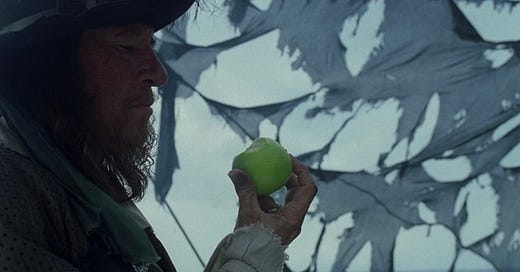Pirates of the Inferno
What has Dante to do with Pirates of the Caribbean? A lot, as it turns out. For one thing, they have Boethius in common. For another, both place a heavy emphasis on the redemptive possibilities of romantic love – and its potential to damn when it goes wrong. In At World’s End, the heroes journey to the afterlife with the help of a map that depicts the world, in Dantean fashion, as a set of revolving concentric circles (and the imagery of the whirlpool finale, too, has Dantean resonance).
Someday, I would like to write a very long essay on the literary underpinnings of the Pirates films (even longer than what I have previously written on the subject), but today I will content myself with a note on the Dantean nature of the titular curse in The Curse of the Black Pearl.
The Curse of the Black Pearl contains the trilogy’s most overt nod to Dante: Jack Sparrow’s statement that “The deepest circle of hell is reserved for betrayers and mutineers.” This is, in fact, true in Dante’s cosmos. The lowest level of the Inferno (the ninth) is the one where treachery is everlastingly punished, with sub-circles named for Cain (a betrayer of family) and Judas (a betrayer of God). At its bottom resides Satan, the original and ultimate betrayer. One of the cursed pirates replies to Jack Sparrow’s somewhat glib remark with the bitter groan: “You know nothing of hell.” The curse of the Aztec gold is, we are meant to understand, a kind of living (or un-living) hell – and it is a Dantean hell at that.
In the first Canto of the Inferno, Dante’s attempt to escape the dark wilderness into which he has been plunged by his straying from the true path is blocked by three beasts: a leopard, a lion, and a she-wolf. It is the she-wolf that terrifies Dante most, so crushing him with fear that he despairs and turns back towards the dark valley:
“Then a she-wolf, whose scrawniness seemed stuffed
with all men’s cravings, sluggish with desires,
who had made many live in wretchedness –
So heavily she weighed my spirit down,
pressing me by the terror of her glance,
I lost all hope to gain the mountaintop.” (1.49-54)
Dante describes the she-wolf as a horrible paradox: she is both scrawny and “stuffed,” filled to the point of sluggishness yet empty to the point of emaciation. As Virgil explains some lines later:
“So vicious is her nature, so ill-bent,
she never stuffs her ravenous will enough,
but after feeding hungers all the more.” (1.97-99)
The she-wolf is a striking image of the nature of sin, which ceaselessly devours without ever achieving real satisfaction. This is the fate to which the greedy and traitorous pirates of the Black Pearl have been subjected by the curse of the Aztec gold – a curse which accurately reflects the state of their vicious souls. Captain Barbossa explains his suffering to Elizabeth Swann in a memorable speech that recalls Dante’s description of the she-wolf:
“Find it, we did. There be the chest. Inside be the gold. And we took ‘em all. Spent ‘em and traded ‘em, frittered ‘em away on drink and food and pleasurable company. The more we gave ‘em away, the more we came to realize the drink would not satisfy. The food turned to ash in our mouths. And all the pleasurable company in the world could not slake our lust. We are cursed men, Miss Turner. Compelled by greed, we were, but now we are consumed by it… Look! The moonlight shows us for what we really are. We are not among the living and so we cannot die, but neither are we dead. For too long I’ve been parched of thirst and unable to quench it. Too long I’ve been starving to death and haven’t died. I feel nothin’. Not the wind on my face, nor the spray of the sea, nor the warmth of a woman’s flesh.”
Dante’s three beasts are open to a number of interpretations. Many commentators have identified them with particular sins: the light-dappled leopard with lust (the most forgivable sin in Dante’s cosmos, because it most nearly resembles the divine light of love), the lion with pride, and the she-wolf with avarice or covetousness. Others link the three beasts to the three enemies of the soul: the leopard is the flesh, the lion is the devil, and the she-wolf is the world. Both interpretations fit Pirates of the Caribbean neatly enough: the pirates’ most prominent vice is, of course, greed, which is an immoderate chasing after the world’s goods, those fleeting and insubstantial gifts of ever-changing fortune. But I also like Charles Williams’ interpretation, advanced in his commentary The Figure of Beatrice, that the three beasts represent the temptations that characterize the three stages of a man’s life: the flashy, quick-moving leopard is Adolescence, the strong and haughty lion is Manhood, and the skeletally lean, perpetually discontented she-wolf is Age. I think this reading maps nicely onto the contrast between the youthfully lighthearted Jack Sparrow (the Peter Pan to Elizabeth’s Wendy) and his nemesis, the craving, cynical Barbossa (the Captain Hook to Jack’s Peter Pan).
In any case, Barbossa’s description of the curse hints at the surprising depth of the Pirates films’ moral vision. As Dante knows, to chase after vice is to doom oneself to never-ending unfulfillment, for (as Milton imagines in Paradise Lost) the fruits of sin always turn to ashes in the mouth of the sinner. The Pirates of the Caribbean trilogy, much like the Divine Comedy, revolves around such morally potent images.




